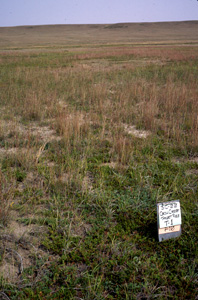Community Field Guide
Scientific Name:
Juniperus horizontalis / Schizachyrium scoparium Dwarf shrubland
Common Name:
Creeping juniper / little bluestem Dwarf shrubland
Community Description
Summary:
This creeping juniper community type is found in the northwestern Great Plains of the United States and Canada. Stands occur on moderate to steep slopes, usually on upper slopes. Soils are silty loam, sandy loam, or clay loam. In North Dakota, Montana, and South Dakota it occurs on north and rarely west facing slopes. In Manitoba it is thought to occur on dry south-facing slopes. Parent materials are sandstone, siltstone, claystone, and sandy glacial till. Short shrubs and graminoids dominate this community. Vegetation cover is moderate to high. The dominant species is usually Juniperus horizontalis, a mat-forming shrub. Other low shrubs include Artemisia frigida, Dasiphora fruticosa ssp. floribunda, Symphoricarpos occidentalis, and Rosa arkansana. Rhus trilobata and Prunus virginiana are taller shrubs that may be present. The most abundant graminoid is Schizachyrium scoparium. Other common graminoids include Calamovilfa longifolia, Carex filifolia, Carex inops ssp. heliophila, Carex duriuscula, Koeleria macrantha, and Muhlenbergia cuspidata. Some of the forbs that are associated with this community are Anemone patens, Campanula rotundifolia, Comandra umbellata, Echinacea angustifolia, Dalea purpurea, Galium boreale, Senecio plattensis, and Linum perenne.
Environment:
Stands occur on moderate to steep slopes, usually on upper slopes (Hansen et al. 1984, USFS 1992). Typically, in the northern plains, stands occur on north and rarely west facing slopes (Johnston 1987), but in Manitoba it is thought to occur on dry south-facing slopes (Greenall 1995). Parent materials are sandstone, siltstone, claystone, and sandy glacial till (USFS 1992). Soil textures include shallow silty loam, sandy loam, or clay loam soil. Hirsch (1985) reported significant amounts of gravel and scoria near the surface.
Vegetation:
Short shrubs and graminoids dominate this community. Vegetation cover is moderate to high. The U.S. Forest Service (1992) found that in 11 stands in western North Dakota the average cover of shrubs was 44%, graminoids cover 32%, and forbs cover 2%. The dominant species is usually Juniperus horizontalis, a mat-forming shrub. Other low shrubs include Artemisia frigida, Dasiphora fruticosa ssp. floribunda, Symphoricarpos occidentalis, and Rosa arkansana. Rhus trilobata and Prunus virginiana are taller shrubs that may be present. The most abundant graminoid is Schizachyrium scoparium. Other common graminoids include Calamovilfa longifolia, Carex filifolia, Carex inops ssp. heliophila, Carex duriuscula (= Carex eleocharis), Koeleria macrantha, and Muhlenbergia cuspidata. Some of the forbs that are associated with this community are Pulsatilla patens (=Anemone patens), Campanula rotundifolia, Comandra umbellata, Echinacea angustifolia, Dalea purpurea, Galium boreale, Senecio plattensis, and Linum perenne. Bare ground may occupy 25%-45% of the surface (Hirsch 1985).
Global Rank: G4 State Rank: S4
Community References
Identifier:
CEGL001394
Author:
J. Drake, MCS; mod. S. V. Cooper & C. Jean, MTNHP
Citations:
DeVelice et al. 1991, Greenall 1995, Hansen et al. 1984, Hirsch 1985, Johnston 1987, Montana Natural Heritage Program 1988, U.S. Forest Service (USFS) 1992
View Detailed Citation Information | New Community Search | NatureServe Explorer Community Information
This information is from the:
Montana Natural Heritage Program
Montana State Library--Natural Resource Information System
1515 East Sixth Ave., Helena, MT 59620-1800
406 444-3989
mtnhp.org
mtnhp@mt.gov






